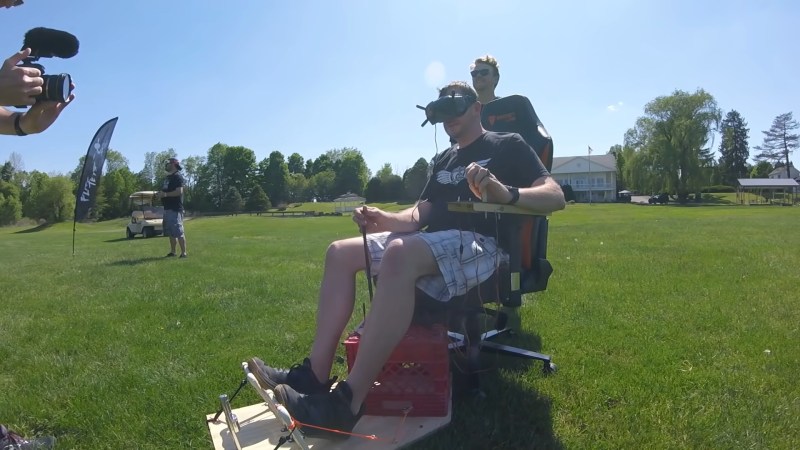First-person view, or FPV, has become hugely popular in RC flying circles. A pair of video goggles lets the pilot fly with vision from the plane itself. To make things even more realistic, the team at [FliteTest] built a replica cockpit with working controls and took it down to the field for testing. (Video, embedded below.)
Since the pilot is wearing video goggles, aesthetics aren’t the key here. A RC transmitter was gutted for its gimbal and potentiometers. The former fitted with a long stick for aileron and elevator control, and the latter hooked up to pedals for the rudder. There’s even a proper throttle handle. It’s a low-budget build, with PVC pipe and bungee straps doing much of the work, but that doesn’t detract from the fun factor one bit. The team later upped the stakes, flying a faster model with the rig at speeds up to 120 mph.
Interesting to note is the somewhat visceral reaction by the pilot when crashing, as the combination of first-person view video and realistic controls gives a powerful sense that one is actually in a real plane. FPV flying actually has a longer history than you might expect, with roots as far back as the 1980s.
















Cool, but not as cool as something I saw ~10 years ago with a guy placing an FPV helmet controlled camera inside the cockpit of a model airplane. When he turned his head, the camera turned accordingly. Remember the awesomeness when he flew the plane over him self and turned his head to look at himself. Come to think of it, I haven’t seen anything cooler ever since. Cannot find the video though..
For me the cool factor here is they made a cockpit seat with rudder pedals and a stick AND throttle out of what looks like bench scrape and dumpster dives and its this effective. THIS is a hack, and its beautiful.
That’s actually not all that uncommon — if not “normal” these days. Put the camera on a servo, have the IMU in your headset send it data, done.
I secretly suspect that it would make me seasick, but what do I know?
Eat some candied ginger and practice, you’d get used to it.
I haven’t seen the video you’re referencing, but I kind of had the same thought, and it’s not terribly hard to do. I mounted a camera on a pan-tilt assembly to an RC car and used the accelerometer on an Arduino Nano BLE strapped to my headset to control it. You’d no doubt want something longer range than BLE for this, maybe LoRa would work?
Obviously with an aircraft you have weight and drag considerations, but maybe mounting it under clear molded parts could help with the wind drag factor?
Over on the FT forum we have claims of 5 mile range fpv, and since many have hung cameras on the plane extra drag/weight doesn’t seem to be too big an issue.
With the current crop of NPRM, check the legality before use. The fines and proposed penalties seem excessive
A lot of FPV headsets have either built-in head tracking or you can get a module for it. Of course, you can make your own if you prefer to.
Then you simply hook up the output-port (HT) to the trainer-port or other input on your RC transmitter.
That way, you shouldn’t have to worry about the range. At least not until you loose complete control of the aircraft.
It does however, require some additional channels.
Funny enough, I’m damn sure there’s a Flite Test video where they did just that.
I watched a 1/13 scale arc Airbus a couple days ago! What is you mad about?
Wonder if golf courses would make some decent money renting their space for FPV?
The number of people they can charge 50-150 bucks for a round of golf every few hours makes for a 5 figure day. So I’d imagine you’d need to pony up several thousand for a weekday. Off season, which are wet seasons, they don’t want you stomping huge muddy holes in the greens.
Next up, a motion feedback chair.
I think we’re seeing the future of fighter planes (well with less pvc and bungies.)